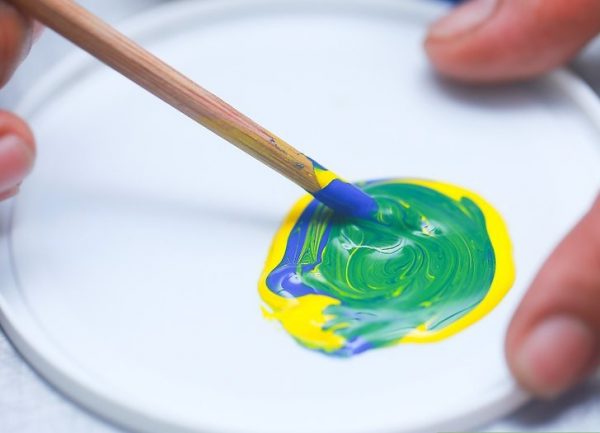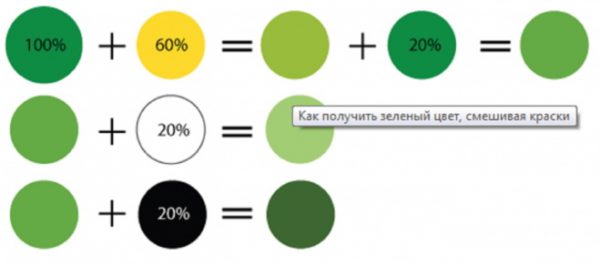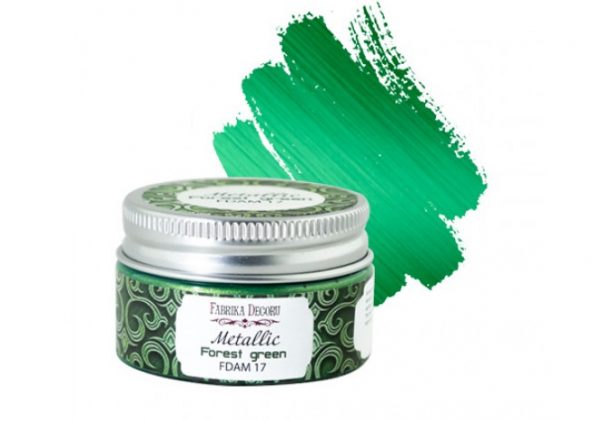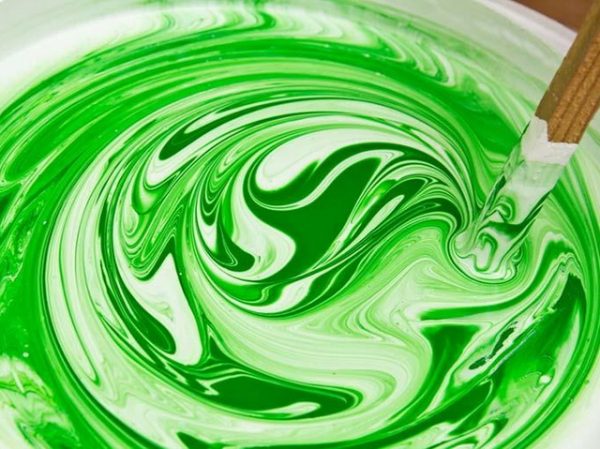Light green creates associations with spring greens, freshness, and renewal of nature. This color, when contemplated, has the property of improving the mood, therefore it is very popular in interior design.
- Coloring Basics
- How to get lime color from paints
- Varieties of green and their manufacture
- Pale green
- Olive
- Bottle green
- Coniferous
- Green fern
- Forest green
- Light green
- Marsh
- Dark green
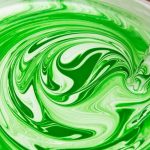
No less often, lettuce is used in painting: for drawing on natural subjects, writing still lifes. It goes well with other shades that are found in everyday life. There is only one minus for this color: it is not included in the basic set of colors and is rarely sold ready-made. How to get a green color when mixing paints? The task is simple, and its solution is available to any beginner.
to contents ↑Coloring Basics
The science of color is called coloristics - its nature, basis and components, basic and additional tones, characteristics and color contrasts. In coloristics, the rules for mixing shades are discussed in detail, all of which are based on knowledge of the color wheel.
Any artist knows that colors are divided into chromatic (color) and achromatic - the latter, when combined, give a gray mass. By mixing yellow, blue and red in different variations and diluting them with black and white, you can get the rest of the many tones and midtones.
to contents ↑Green and its varieties can also be made with your own hands, for this you only need a basic set of gouache, watercolors, acrylic or other types of paints. The color can be lightened or darkened, as well as add new notes to it.
How to get lime color from paints
There are many options for making light green color from different colors. For work, in addition to colors, you need a white palette, brushes and a palette knife, a water jar, paper napkins for cleaning tools. The easiest way is to create a clarified green tone by introducing white into the finished green paint. The latter can also be created with your own hands: mix blue and bright yellow in equal proportions.
to contents ↑With the help of white paint, it is easy to lighten any green shade that is available. But most often it turns out not juicy enough, without a characteristic light green yolk. In this case, a little yellow color is dripped into the paint and thoroughly mixed until a uniform green color is obtained.
Varieties of green and their manufacture
There are about fifteen green tones that are most often used in painting: there are pale, and bright, and blue-green shades. Artists also know more than 110 subtones of green, differing in less significant nuances. Usually the combination of green with blue shades is used in winter images, and the addition of yellow with the formation of light green is more popular in summer motifs.
to contents ↑Pale green
Pastel colors always look beautiful and noble.They have a soothing, calming effect, therefore, they are often used for painting walls in children's and medical institutions. The same shades are used in the interior of bedrooms and children's rooms, they set in a calm mood, help to relax. To get pale green, you just need to dilute the existing green paint with white.
Olive
This color looks luxurious in the interior, it is soft and juicy. Making olive color is difficult, but experimenting is possible. First you need to cook a regular green tone, then add a drop of yellow and darken with brown paint. The result should be a dark yellowish-green color: this is what the real olive fruit looks like.
to contents ↑Bottle green
Bottle glass has a deep, dark, resembling emerald hue. It is based on the mixing of blue paint with yellow to obtain a classic green. Then the tone is darkened with black, but they act with extreme caution: otherwise it will turn out dirty, grayish. If you want to give the bottle a hint of blue, they make it dark with this color.
Coniferous
It is not difficult to make a shade of needles: first, green is clarified by introducing yellow, and then a little black paint is dripped. To create needles in the picture in fog or powdered with snow, you can drip white paint into the finished color.
Green fern
The shade of fern implies the combination of a usual green tone with a drop of black and subsequent lightening with white. The final hue will be transitional from dark green to light. It is very widely used in facade decoration for painting walls of a house.
Forest green
Usually a shade of fresh green is a classic green tone. Also, to reflect the juicy color of the foliage, a tiny drop of yellow is introduced into it, which will make the drawing fresh, spring. To create the gloominess of the forest, it is permissible to use a black and green hue, it is only important not to overdo it with a dark color.
to contents ↑Light green
In addition to the standard method - mixing green with yellow and white, there are other methods for preparing green color. For example, you can add a large amount of yellow tint a drop of dark blue or blue with black - the result will be the same.
to contents ↑An interesting color is obtained from mixing yellow with turquoise in approximately equal amounts. The more turquoise will be in the final tone, the richer it will turn out. In the interior, lime is used to paint individual details. In a large volume, it is usually not used, except in expressive style directions.
Marsh
This color is created by combining green, brown paint and a drop of red tone. It resembles khaki, only has a greater reflection of greenery than the last. In the interior, swamp tone is most often used accent, because in a significant amount it can give the room a gloom.
Dark green
Black, gray, brown tones are traditionally used to darken greenery. The amount of additives is selected experimentally. In painting and decor, this dark background is used to a limited extent, but in the form of separate accents it will add a twist to the image and turn it into a real masterpiece.

